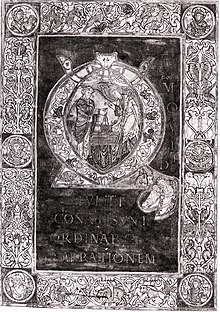Bertin(Latin:Bertinus;c.615 –c.709 AD), also known asSaintBertin the Great,was theFrankishabbotof amonasteryinSaint-Omerlater named theAbbey of Saint Bertinafter him. He is venerated as a saint by the Catholic and Orthodox Churches. The fame of Bertin's learning and sanctity was so great that in a short time more than 150 monks lived under his rule. Among them wereSt. Winnocand his three companions who had come from Brittany to join Bertin's community and assist in the conversions. Nearly the whole Morini region was Christianized.
Saint Bertin the Great | |
|---|---|
 Illustration of St. Bertin | |
| Born | c. 615 Constance,DuchyofAlamannia,Frankish Kingdom |
| Died | c. 709 Abbey of Saint Peter,Saint-Omer,Frankish Kingdom |
| Venerated in | Catholic Church Eastern Orthodox Church |
| Majorshrine | Abbey of St. Bertin |
| Feast | 5 September |
Life
editBertin was born nearConstance,then in theFrankishDuchyofAlamannia.At an early age, he entered theAbbey of Luxeuil,where, under the austere rule of its abbot,Columbanus,he prepared himself for a futuremissionarycareer. About the year 638 he set out, in company with two confrères,MummolinandEbertram,for the extreme northern part of France in order to assist his friend and kinsman,BishopOmer,[1]in the evangelization of theMorini.This country, now in theDepartmentofPas-de-Calais,was then one vast marsh, studded here and there with hillocks and overgrown with seaweed and bulrushes. On one of these hillocks, Bertin and his companions built a small house and they went out daily to preach the Christian faith to the natives, most of whom were still pagans.
Gradually some converted pagans joined the little band of missionaries and a larger monastery had to be built. A tract of land calledSithiuhad been donated to Omer by a converted nobleman namedAdrowald.Omer now turned this whole tract over to the missionaries, who selected a suitable place on it for their new Abbey ofSt. Peter.Additional villages[2]were granted byCount Waldebert,later a monk at Bertin's monastery of Sythiu and eventually Abbot of Luxueil and canonized, who gave his son at the baptismal font to Bertin, from whom the boy received his name and his education.[3]The community grew so rapidly that in a short time this monastery also became too small and another was built where the city of St. Omer now stands.
The fame of Bertin's learning and sanctity was so great that in a short time more than 150 monks lived under his rule, among them St.Winnocand his three companions who had come fromBrittanyto join Bertin's community and assist in the conversion of the heathen. When nearly the whole region wasChristianized,and the marshy land transformed into a fertile plain, Bertin, knowing that his death was not far off, appointedRigobertas his successor, while he himself spent the remainder of his life preparing for a happy death. Bertin began to beveneratedas a saint soon after his death. Hisfeast dayis celebrated on 5 September.
Mummolin, perhaps because he was the oldest of the missionaries, was abbot of the two monasteries until he succeeded the deceasedEligiusasBishop of Noyon,about the year 659. Waldebert's son Bertin, adopted by Bertin the founder, then became the third abbot.[4]
In later times the abbey became famous as a centre of sanctity and learning. About the 11th century, the name of the abbey was changed that of Saint-Bertin.[5]TheAnnales Bertiniani(830–882;Mon. Germ. Hist. Script.I, 419–515) are important for the contemporary history of theWest Frankish Kingdom.[6]The abbey church, now in ruins, was one of the finest 14th-centuryGothicedifices. In later times, its library, archives, and art-treasures were renowned both in and out of France.
The monks were expelled in 1791 by the invading forces of theFrench Revolutionary Armyand in 1799 the abbey and its church were sold at auction.
His iconography is aboatas his home town,Sithiuwas only accessible by water in Bertins time. Afeast dayis celebrated on 5 September, and his cult was taken to England with theNorman Invasion.[7]
See also
editNotes
edit- ^David Farmer, Oxford Dictionary of Saints (Oxford University Press,1992) p54.
- ^Arques with its associated rights, Sythiu, Longuenesse, Quelmes, Acquin, Coyecques, Audenfort and Escales are mentioned byLambert of Ardres,(Lambert, Leah Shopkow, tr.,The History of the Counts of Guines and Lords of Ardresch. 3.3.
- ^Lambert ch. 3.3.
- ^The list of abbots is given inGallia Christiana nova,III, 485 sqq. See Henri de Laplane,Les abbés de Saint-Bertin d'après les anciens monuments...(St. Omer, 1854–55).
- ^"St. Bertin, Abbot",Alban Butler:The Lives of the Saints(1866), vol. IX
- ^The charters of the abbeyare publishedin M. Guérard,Cartulairede l'abbaye de St. Bertin(Paris, 1841; appendix by Morand, ibid., 1861).
- ^David Farmer, Oxford Dictionary of Saints, (Oxford University Press, 1992) p54.
References
edit- This article incorporates text from a publication now in thepublic domain:Ott, Michael (1907). "St. Bertin".In Herbermann, Charles (ed.).Catholic Encyclopedia.Vol. 2. New York: Robert Appleton Company.